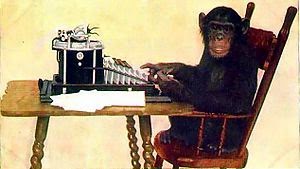 |
| Jacques Monod |
In his
famous popular book Le hasard et la nécessité
(1970), Jacques Monod said that evolution is the result of the interaction of
two types of phenomena: chance (mutations, environmental changes)
and necessity
(natural selection) .
More
precisely, natural selection can be considered as the action of a random
element (the environment) over another random element (the genetic make-up of
living beings). According to the synthetic theory of evolution, who is now over
80 years old, that action is quasi-deterministic (Monod’s nécessité).
A further
development of the synthetic theory of evolution is Richard Dawkins’s selfish
gene theory, which asserts that adult living beings are just the means that
allow genes to perpetuate. Although it had some significant detractors (Stephen
Jay Gould, for instance), this theory was accepted by many biologists in the
two decades after its statement.
However, in
recent years, advances in genomics and evolutionary biology are beginning to
question the accuracy of the synthetic theory of evolution and the selfish
gene. Make no mistake: this does not mean that the theory of evolution is in
question, what is being discovered is the fact that things are not as simple as
they seemed. The following is a sample of some of the problems detected, culled
from the book The year in evolutionary biology,
Annals of the New York Academy of Sciences (2008).
·
Epigenesis:
genes are more interconnected than thought. A mutation in a gene can make another
gene work in a completely different manner, complicating the action of natural
selection.
·
Quasi-neutrality: slightly deleterious mutations seem to be immune to natural selection
and are perpetuated over generations.
·
The
development and hybridization of viviparous beings (which include such
different organisms as mammals and flowering plants, among others) are not as
simple as implied by the Dobzhansky-Muller principle, associated with the
synthetic theory of evolution. Hitherto unsuspected effects take a part, such
as genomic imprinting (substantial differences in the expression of maternal
and paternal genes during development).
 |
| The tree of life |
·
The
fundamental dogma of the synthetic theory (the genotype
uniquely determines the phenotype) is now questionable. Not only
it is true (what was already known) that the genotype is plastic, and depending
on the environment can lead to several different phenotypes (to see this, just
compare the different types of cells of the same organism, which are very
different, although they share the same genome). What is unexpected is the
finding that several different genotypes may result in the same phenotype; a
setback for Dawkins’s selfish gene theory. The relationship between genotype
(genes) and phenotype (the physical aspect of the living adults) happens to be many-to-many
in both directions, and the development of the phenotype from the genotype is
more deeply influenced by the environment than previously thought.
Manuel Alfonseca
.jpg)

